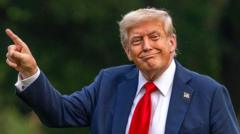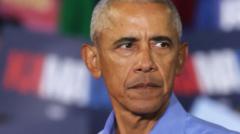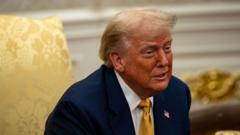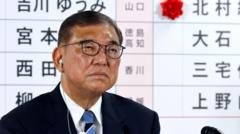President Trump's aggressive tariff approach is yielding results with Japan, marking a significant win for his administration in a complex global trade landscape. While Japan benefits from negotiations, questions remain about the future impact on consumers and international relations.**
Trump's Tariff Strategy Shows Early Success with Japan Deal**
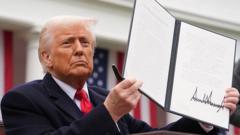
Trump's Tariff Strategy Shows Early Success with Japan Deal**
The US's recent trade agreement with Japan highlights potential shifts in global economics and tariff diplomacy.**
In a significant move in the ongoing global trade landscape, President Donald Trump's tariff strategy appears to be paying off with a recent trade agreement with Japan. Starting with an assertive stance, the Trump administration has been persistent in its negotiations, which has now culminated in a deal that positions Japan favorably among other nations with substantial trade surpluses with the US.
Early discussions hinted at progress, yet for a time, negotiations felt stagnant. However, with Japan now securing what can be interpreted as the best deal available under the current circumstances, other nations may be compelled to follow suit. The agreement entails a 15% tariff on Japanese imports, which, although higher than the UK's 10%, represents a significant development due to Japan's existing trade surplus with the US.
During talks, Japanese officials demonstrated a robust negotiating position, leveraging the country's hefty $1.1 trillion in US Treasury bonds, the most significant such holding globally. The fear stemming from potential hedge fund sell-offs of these bonds, prompted by the initial "Liberation Day" tariffs outlined by Trump, set the stage for this critical agreement.
The implications of this deal extend beyond Japan, particularly as it sends a message to other economic powerhouses, including the European Union, currently grappling with retaliation strategies against the US. As tensions rise in Europe, particularly with Germany and France considering counteractions, the timing of Japan's agreement could curb any coordinated efforts from the EU.
As details of the agreement emerge, it is clear that Japan has effectively negotiated protections for its agricultural sector, albeit allowing for some increased US rice imports. On the other hand, the attractiveness of large American vehicles remains unaddressed, despite investments anticipated from Japanese firms, reaching up to $500 billion in various sectors in the US.
Amidst this backdrop of evolving trade policies, Japan's proactive stance may have been influenced by domestic political vulnerabilities facing Prime Minister Abe. Interestingly, other nations, like Indonesia and the Philippines, have also pursued similar trade agreements, highlighting a potential shift in global diplomatic tactics.
The overarching narrative suggests an overarching acceptance of the US’s unconventional tariff policies, despite significant backlash a year ago. Currently, tariffs are generating impressive revenue for the US Treasury, accounting for roughly 5% of federal income this year—far exceeding historical contributions.
Yet, as the tariffs rise, the question of consumer impact looms large. Ultimately, American consumers may bear the brunt of increased prices on imported goods—an unexpected outcome considering earlier forecasts suggested a stronger dollar would ease costs. Conversely, the dollar has weakened considerably, creating further complications in the market.
This evolving economic situation contributes to a larger narrative regarding the shifting dynamics of global trade and competitor positioning, particularly for rivals like China. As the first act in this escalating trade confrontation concludes, the US-Japan deal showcases a substantive win for Trump’s administration, potentially reshaping perceptions of his negotiation effectiveness while the broader economic environment remains fraught with uncertainty.



